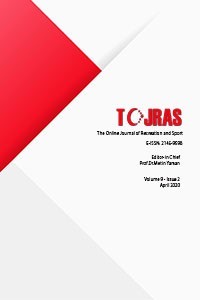ANALYZING OF THE EXCERCISE ADDICTION IN INDIVUALS ENGAGED WITH INDIDIVDUAL AND TEAM SPORTS
ANALYZING OF THE EXCERCISE ADDICTION IN INDIVUALS ENGAGED WITH INDIDIVDUAL AND TEAM SPORTS
Free time management university student, academic success,
___
- 1. Adams, J., Kirkby, R.J. (2002). Excessive Exercise as an Addiction: A Review. Addiction Research and Theory,10: 415-437.
- 2. Adams, J. M., Miller, T.W., Kraus, R.F., (2003). Exercise Dependence: Diagnostic and Therapeutic Issues for Patients in Psychotherapy. Journal of Contemporary Psychotherapy, Vol. 33, No. 2,93-107.
- 3. American Psychiatric Association, (1994). Diagnostic and Statistical Manual of Mental Disorders, 4th Edn. American Psychiatric Association, Washington, DC.
- 4. Baltacı, G., Düzgün, İ., (2008). Adolescence and Exercise. No:730, s:7, Ankara: Publication of the Ministry of Health.
- 5. Bavlı, Ö., Kozanoğlu, M., Doğanay, A. (2011) Effect of Participation to Regular Exercise on Exercise Addiction, Physical Education and Sports Science Journal of the Selcuk University,13(2): 150–153
- 6. Berczik, K., Szabó, A., Griffiths, M. D., Kurimay, T., Kun, B., Urbán, R., & Demetrovics, Z. (2012). Exercise addiction: symptoms, diagnosis, epidemiology, and etiology. Substance use & misuse, 47(4), 403-41.
- 7. Costa, S., Cuzzocrea, F., Hausenblas, H.A., Larcan, R. & Oliva, P. (2012). Psychometric examination and factorial validity of the Exercise Dependence ScaleRevised in Italian exercisers. Journal of Behavioral Addictions, 1, 186–190.
- 8. Hamer, M., Karageorghis, C. I. (2007). Psychobiological mechanisms of exercise dependence. Sports medicine, 37(6), 477-484.
- 9. Hausenblas, H.A., Downs, D.S. (2002). Exercise Dependence: A Systematic Review. Psychology Sport and Exercise, 3: 89-123.
- 10. Lejoyeux, M., Avril, M., Richoux. C., Embouazza, H., Nivoli, F. (2008) Prevalence of exercise dependence and other behavioral addictions among clients of a parisian fitness room. Compr Psychiatry, 49:353-358.
- 11. Mónok, K., Berczik, K., Urbán, R., Szabó A., Griffiths, M. D., Farkas, J., Magi, A., Eisinger, A., Kurimay, T., Kökönyei, G., Kun, B., Paksi, B. & Demetrovics, Z. (2012). Psychometric properties and concurrent validity of two exercise addiction measures: A population wide study in Hungary. Psychology of Sport and Exercise, 13, 739–746.
- 12. SZABO, A.; (1995). The Impact of Exercise Deprivation on Well-being of Habitual Exercisers. Australian Journal of Science and Medicine in Sport, 27: 68-75.
- 13. SZABO, A.; (1998). Studying the Psychological Impact of Exercise Deprivation: Are Experimental Studies Hopeless? Journal of Sport Behavior, 21: 139–147.
- 14. Uzun, M., (2007). Patient Raining and Exercise in Cardiac Rehabilitation. Anatolian Cardiology Journal. 7,298-304.
- 15. Yates, A.; (1991). Compulsive Exercise and the Eating Disorders: Toward an Integrated Theory of Activity. Brunner/Mazel, New York.
- 16. Yeltepe, H., İkizler, C. (2007), Exercise Addiction Scale – 21’in Turkish Effectiveness and Reliability Study, Addiction Journal, 8: 1:29-35
- 17. Vardar, E., Vardar SA, Toksöz İ, Süt N.,(2012). Evaluation of exercise addictions and psychopathological characteristics. Psychiatric and Neurologic Science Journal “Thinking Man”. 25:51-57
- 18. Villella, C., Martinotti, G., Di Nicola, M., Cassano, M., La Torre, G., Gliubizzi, M. D., Messeri, I., Petruccelli, F., Bria, P., Janiri, L. & Conte, G. (2011). Behavioural addictions in adolescents and young adults: Results from a prevalence study. Journal of Gambling Studies, 27, 203–214
- 19. Zmijewski, C.F., Howard, M.O. (2000). Exercise Dependence and Attitudes Toward Eating Among Young Adults. Eating Behaviors, 4: 181-195.
- ISSN: 2146-9598
- Yayın Aralığı: Yılda 4 Sayı
- Başlangıç: 2012
- Yayıncı: METİN YAMAN
H Nur ZORBA, Ercan ZORBA, Merve KARAMAN
ANALAZING THE EFFECTS OF PLATELET ON THE DURABILITY TRAINING
DETERMINATION OF THE PEOPLE’S SATISFACTION WHO GO TO THE ZOO FOR RECREATIONAL ACTIVITY
AN EVALUATION OF TURKISH POLICE OFFICER’S VIEW ON VIOLENCE IN FOOTBALL AND HOOLIGANISM
Ercan ZORBA, T Osman MUTLU, Akan BAYRAKDAR
ANALYSING WOMAN FOOTBALLERS^SOME PHYSICAL RATES ACCORDING TO THEIR PLAYING POSITIONS AND AGES
Kenan UZUN, Bekir MENDEŞ, Ayhan TEPE
THE RELATIONSHIP BETWEEN UNIVERSITY STUDENTS’ FREE TIME MANAGEMENT AND ACADEMIC SUCCES
Emrah SERDAR, Duygu Harmandar DEMİREL, Mehmet DEMİREL, Veli Ozan ÇAKIR
ANALYZING OF THE EXCERCISE ADDICTION IN INDIVUALS ENGAGED WITH INDIDIVDUAL AND TEAM SPORTS
